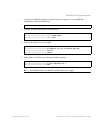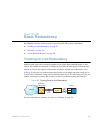
BLADEOS 6.5.2 Application Guide
318 Chapter 22: Basic Redundancy BMD00220, October 2010
Hot Links
For network topologies that require Spanning Tree to be turned off, Hot Links provides basic link
redundancy with fast recovery.
Hot Links consists of up to 25 triggers. A trigger consists of a pair of layer 2 interfaces, each
containing an individual port, trunk, or LACP adminkey. One interface is the Master, and the other
is a Backup. While the Master interface is set to the active state and forwards traffic, the Backup
interface is set to the standby state and blocks traffic until the Master interface fails. If the Master
interface fails, the Backup interface is set to active and forwards traffic. Once the Master interface is
restored, it transitions to the standby state and blocks traffic until the Backup interface fails.
You may select a physical port, static trunk, or an LACP adminkey as a Hot Link interface.
Forward Delay
The Forward Delay timer allows Hot Links to monitor the Master and Backup interfaces for link
stability before selecting one interface to transition to the active state. Before the transition occurs,
the interface must maintain a stable link for the duration of the Forward Delay interval.
For example, if you set the Forward delay timer to 10 seconds, the switch will select an interface to
become active only if a link remained stable for the duration of the Forward Delay period. If the link
is unstable, the Forward Delay period starts again.
Preemption
You can configure the Master interface to resume the active state whenever it becomes available.
With Hot Links preemption enabled, the Master interface transitions to the active state immediately
upon recovery. The Backup interface immediately transitions to the standby state. If Forward Delay
is enabled, the transition occurs when an interface has maintained link stability for the duration of
the Forward Delay period.
FDB Update
Use the FDB update option to notify other devices on the network about updates to the Forwarding
Database (FDB). When you enable FDB update, the switch sends multicasts of addresses in the
forwarding database (FDB) over the active interface, so that other devices on the network can learn
the new path. The Hot Links FBD update option uses the station update rate to determine the rate at
which to send FDB packets.


















